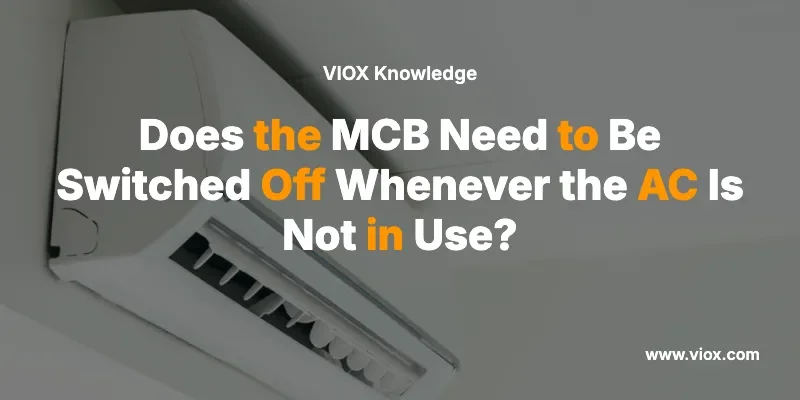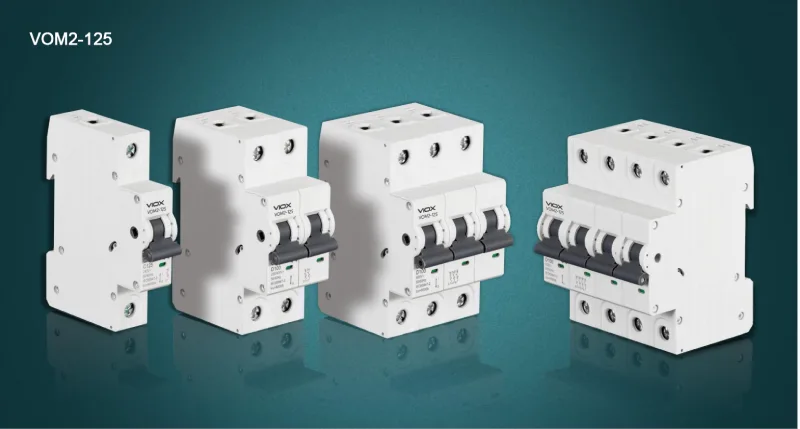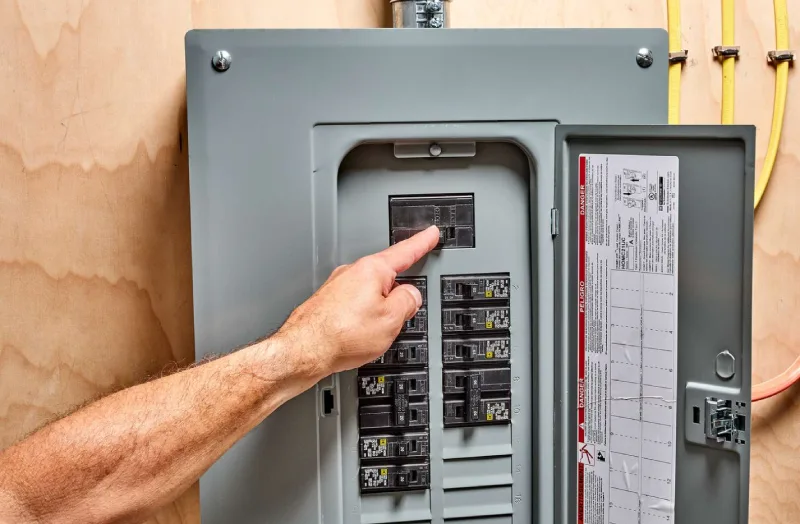Quick Answer: No, you don’t need to switch off the MCB (Miniature Circuit Breaker) every time you turn off your air conditioner. The MCB is a safety device designed to remain on continuously, protecting your circuit from overloads and short circuits. Only switch off the MCB during maintenance, extended absence (30+ days), or electrical emergencies.
Understanding when to operate your AC’s MCB can significantly impact your electrical safety, system longevity, and energy costs. This comprehensive guide explains the proper MCB management for air conditioning systems, helping you make informed decisions about electrical safety in your home or office.
What Is an MCB and How Does It Relate to Your Air Conditioner?
An MCB (Miniature Circuit Breaker) is an automatically operated electrical switch designed to protect electrical circuits from damage caused by overload or short circuit. Unlike a regular switch, an MCB automatically trips when it detects excessive current flow, preventing potential fires and equipment damage.
Your air conditioner typically has a dedicated MCB in your electrical panel, rated between 16-32 amps depending on the AC capacity. This dedicated circuit ensures your high-power AC unit doesn’t interfere with other electrical systems while providing essential overcurrent protection.
Key MCB Functions for AC Systems:
- Automatic disconnection during electrical faults
- Manual control for maintenance purposes
- Overload protection preventing wire damage
- Short circuit protection within milliseconds
- Arc fault protection in modern units
MCB vs. Regular AC Switch: Understanding the Key Differences
Understanding the distinction between your MCB and regular AC switch is crucial for proper system management and safety.
| Feature | MCB (Circuit Breaker) | Regular AC Switch/Remote |
|---|---|---|
| Primary Purpose | Safety protection device | Daily operational control |
| Location | Electrical panel/distribution board | Wall-mounted or remote control |
| Usage Frequency | Rarely operated (maintenance only) | Daily on/off operation |
| Protection Level | Overload, short circuit, ground fault | No protection features |
| Reset Capability | Manual reset after trip | Simple on/off function |
| Current Rating | Matched to circuit capacity (16-32A) | Rated for switching, not protection |
| Lifespan Impact | 10,000+ operations | 100,000+ operations |
| Safety Features | Arc suppression, thermal protection | Basic switching only |
Expert Tip: Think of the MCB as your AC’s insurance policy – it’s there for emergencies, not daily use. Your regular AC switch or remote is designed for frequent operation.
When Should You Actually Turn Off the AC’s MCB?
While daily MCB operation isn’t necessary, specific situations require switching it off for safety and system protection.
Situations Requiring MCB Switch-Off:
- During AC Maintenance or Servicing
- Ensures complete electrical isolation
- Protects technicians from electrical hazards
- Required by electrical safety codes
- Extended Absence (30+ Days)
- Prevents standby power consumption
- Protects against voltage surges during storms
- Reduces fire risk from unattended equipment
- Severe Weather Warnings
- Lightning storm approaching
- Flood warnings in your area
- Hurricane or cyclone preparations
- Electrical Work in Your Home
- Panel upgrades or modifications
- Adding new circuits
- Any work near AC wiring
- System Malfunction Signs
- Burning smell from AC unit
- Unusual sounds or sparking
- Repeated MCB tripping
Situations NOT Requiring MCB Switch-Off:
- Daily AC usage cycles
- Overnight shutdown
- Weekend absence
- Seasonal changes
- Regular cleaning
- Filter replacement
Safety Warning: If your MCB trips repeatedly, do NOT keep resetting it. This indicates a serious electrical problem requiring professional inspection. Continued resetting could lead to fire hazards or equipment damage.
The Real Impact: What Happens When You Switch MCB On/Off Frequently?
Frequent MCB operation can have several negative consequences that many homeowners don’t realize until problems develop.
Mechanical Wear Effects:
- Contact Degradation: Each MCB operation causes microscopic wear on the internal contacts. While MCBs are rated for approximately 10,000 mechanical operations, unnecessary daily switching can reduce this lifespan by 50-70%.
- Spring Mechanism Fatigue: The internal spring mechanism that enables the trip function can weaken with excessive manual operation, potentially compromising the MCB’s protective capabilities when actually needed.
- Arc Damage Accumulation: Every switch operation creates a small electrical arc. Frequent switching increases carbon buildup on contacts, eventually leading to overheating and failure.
Electrical System Stress:
| Impact Area | Effect of Frequent Switching | Long-term Consequence |
|---|---|---|
| Inrush Current | 5-7x normal current on startup | Premature capacitor failure |
| Voltage Spikes | Transient spikes up to 1000V | Electronic board damage |
| Power Quality | Harmonic distortion increases | Reduced component lifespan |
| Connection Points | Thermal cycling stress | Loose connections, arcing |
| Compressor Motor | Hard starts without soft-start | Bearing wear, efficiency loss |
Energy Consumption: MCB Position and Standby Power Facts
A common misconception is that keeping the MCB on wastes significant electricity when the AC is off. Here’s the reality:
Actual Standby Power Consumption:
Modern AC Units (2015+):
- Standby consumption: 1-5 watts
- Monthly cost: $0.15-0.75
- Annual energy: 8-44 kWh
Older AC Units (Pre-2015):
- Standby consumption: 5-15 watts
- Monthly cost: $0.75-2.25
- Annual energy: 44-131 kWh
What Uses Standby Power:
- Memory circuits maintaining settings
- Remote control receiver circuits
- Display panels and indicators
- Crankcase heaters (in some models)
- Control board power supplies
Expert Tip: The energy saved by switching off the MCB daily is negligible compared to the potential repair costs from premature MCB failure. Focus on proper AC usage patterns and regular maintenance for real energy savings.
Best Practices for AC Electrical Management
Implement these professional strategies to maximize safety and system longevity while minimizing energy costs.
Daily Operation Protocol:
- Use the AC’s Built-in Controls
- Remote control for on/off
- Timer functions for scheduling
- Temperature settings for efficiency
- Seasonal Shutdown Procedure
- Clean filters and coils
- Run fan-only mode to dry system
- Cover outdoor unit
- Leave MCB on unless 60+ day absence
- Monthly Safety Checks
- Test MCB trip function (once per month)
- Visual inspection for burn marks
- Listen for unusual buzzing
- Check for warm electrical panels
Energy-Saving Alternatives to MCB Switching:
| Method | Energy Savings | Safety Impact | Cost |
|---|---|---|---|
| Smart Thermostat | 15-25% | Improves | $150-300 |
| Timer Switch | 10-15% | Neutral | $30-50 |
| Isolation Switch | 5-10% | Improves | $50-100 |
| Power Monitor | 5-10% | Neutral | $25-75 |
| Voltage Stabilizer | 5-15% | Improves | $100-200 |
Maintenance Schedule for Optimal Performance:
- Monthly: Clean or replace filters, check drainage
- Quarterly: Test MCB function, inspect electrical connections
- Annually: Professional service, thermal imaging scan
- Every 3 Years: MCB replacement (if frequently operated)
Troubleshooting: When Your MCB Trips Frequently
Frequent MCB tripping indicates underlying problems requiring immediate attention.
Common Causes and Solutions:
- Overloaded Circuit
- Symptoms: Trips when AC starts, especially with other appliances
- Solution: Dedicated circuit installation
- Failing Compressor
- Symptoms: Trips after running 10-15 minutes
- Solution: Professional compressor testing
- Electrical Short
- Symptoms: Immediate tripping upon reset
- Solution: Emergency electrician required
- Undersized MCB
- Symptoms: Trips during normal operation
- Solution: Proper MCB sizing by electrician
- Loose Connections
- Symptoms: Random tripping, burning smell
- Solution: Connection tightening and inspection
MCB Testing Procedure:
- Turn off all connected loads
- Reset MCB to ON position
- Press TEST button (if available)
- MCB should trip immediately
- Reset and restore power
- If test fails, replace MCB immediately
Expert Tip: Keep a log of MCB trips including date, time, and weather conditions. This helps technicians diagnose intermittent problems.
Quick Reference Guide: MCB and AC Management
DO’s:
- Keep MCB on during normal AC operation
- Use remote/wall switch for daily control
- Switch off MCB during extended absence (30+ days)
- Test MCB function monthly
- Maintain dedicated circuit for AC
- Install surge protection devices
- Schedule annual professional inspection
DON’Ts:
- Use MCB as daily on/off switch
- Ignore repeated tripping
- Reset MCB without investigating cause
- Modify MCB ratings yourself
- Operate MCB with wet hands
- Bypass MCB protection
- Delay repairs on faulty MCBs
Frequently Asked Questions
What happens if I leave my MCB on when not using AC for months?
Leaving the MCB on during extended non-use poses minimal risk in modern systems. The standby power consumption is negligible (1-5 watts), costing less than $1 monthly. However, for absences exceeding 30 days, switching off the MCB provides protection against power surges and eliminates any fire risk from unattended electrical equipment.
Why does my AC MCB trip only during hot weather?
Hot weather causes increased electrical load as your AC works harder to cool. The ambient temperature also affects the MCB’s trip threshold – MCBs are calibrated at 30°C, and higher temperatures reduce their current capacity by 5-10%. This combination can cause nuisance tripping. Solutions include upgrading to a temperature-compensated MCB or improving ventilation around your electrical panel.
Can frequent MCB switching damage my air conditioner?
Yes, frequent MCB switching can damage your AC through repeated inrush current stress. Each startup draws 5-7 times normal current, stressing the compressor motor, capacitors, and electronic controls. This can reduce your AC’s lifespan by 20-30% and void manufacturer warranties. Use the regular AC controls for daily operation instead.
What size MCB do I need for a 1.5-ton split AC?
A 1.5-ton split AC typically requires a 16-20 amp MCB with C-curve characteristics. The exact size depends on your voltage (220V or 240V) and the AC’s efficiency rating. Always consult the manufacturer’s specifications and have a licensed electrician perform the installation to ensure code compliance and safety.
Should I turn off the MCB during thunderstorms?
Yes, switching off the MCB during severe thunderstorms provides additional protection against lightning-induced power surges. While surge protectors offer primary defense, physically disconnecting via the MCB ensures complete isolation. This is especially important in lightning-prone areas or if your home lacks whole-house surge protection.
How do I know if my MCB is failing?
Signs of MCB failure include: frequent unexplained tripping, failure to trip during test procedure, visible burn marks or discoloration, unusual buzzing or humming sounds, warm or hot panel surface, and flickering lights when AC starts. Any of these symptoms require immediate professional inspection and likely MCB replacement.
Is it safe to reset a tripped MCB immediately?
No, never immediately reset a tripped MCB. First, identify and resolve the cause of tripping. Turn off all connected appliances, wait 5 minutes for any thermal issues to cool, then reset. If it trips again immediately, call an electrician. Repeated resetting without addressing the cause can lead to fires or equipment damage.
What’s the difference between MCB and MCCB for AC systems?
MCBs (Miniature Circuit Breakers) handle currents up to 125 amps and are suitable for residential AC units. MCCBs (Molded Case Circuit Breakers) handle 125-1000+ amps for commercial/industrial applications. MCBs are more compact, cost-effective, and appropriate for home AC systems under 5 tons. MCCBs offer adjustable trip settings and higher interrupting capacity for larger installations.
Conclusion: Smart MCB Management for Safety and Efficiency
Your AC’s MCB should remain on during normal operation – it’s a safety device, not a daily switch. Reserve MCB operation for maintenance, extended absences, or emergencies. This approach ensures continuous protection, extends equipment life, and maintains electrical safety compliance.
For optimal AC management, focus on proper usage patterns, regular maintenance, and appropriate control methods rather than frequent MCB switching. When in doubt, consult qualified HVAC technicians or licensed electricians who can assess your specific system and provide customized recommendations.
Remember: The MCB is your AC system’s guardian angel – let it do its job by keeping it on and ready to protect your investment and safety.
For professional AC installation, maintenance, or electrical concerns, always consult licensed technicians in your area. This guide provides general information and should not replace professional assessment of your specific situation.




